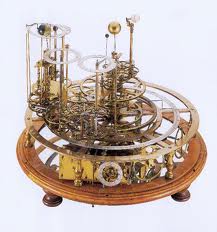Innovation in Dynamic Networks
By Greg Fisher
This is the second of two blog articles that follow on from NESTA’s roundtable on Systemic Innovation. The previous blog focused on systems, whereas this one is about innovation.
How we view social systems has been fundamentally challenged in recent decades by the emerging science of complex systems. Stuart Kauffman described this well in his book Re-Inventing the Sacred where he contrasted the Laplace view of a clockwork universe with one of an inherently creative and uncertain universe.
In the Laplace-inspired view, which emerged during the Enlightenment, there is only fundamental physics (the study of sub-atomic particles and even smaller “stuff”) and applied physics. In Laplace’s view, the latter can be determined from the former, which means the present can be fully understood and the future predicted. In this interpretation of the universe, there is only stuff bouncing around in the void with a set of fixed and – in principle – identifiable laws that fully describe how they bounce. In this universe, creativity is irrelevant.
Our understanding of the universe’s complexity has improved significantly in recent decades, through the new science of complex systems, which has helped us see that innovation plays a central role in it. Moreover, while my two blog articles emphasise different things – systems and innovation – it should be clear that they are related: innovation plays a fundamental role in the dynamics of complex systems.
Kauffman explained that a core concept missing from Laplace’s view is that of emergence. Some people view this as the central principle of complex systems because from it springs a fundamentally different view of the universe at large and social systems more specifically. Emergence is the idea that if we combine two or more “things” then what we get might be something genuinely different to the two constituent parts, which was not predictable beforehand. For example, Kauffman pointed out that nobody has been able to determine the properties of water from its constituent atoms of hydrogen and oxygen. We only know the properties of water from empirical observation. This might sound unbelievable but it is nevertheless true and it holds for all molecules and their constituent atoms. Kauffman described this as a “quiet scandal”, explaining that the properties of water are emergent, meaning the universe is inherently creative.
Anyway, this is all very interesting but what does it mean for systemic innovation? Here I thought it might be useful to distinguish between two different forms of innovation. My description of emergence is important for distinguishing between these two types.
 There is no point in me re-inventing the wheel here because I can refer to the work of W. Brian Arthur. Specifically, Arthur wrote a book called The Nature of Technology, in which he usefully distinguished between two forms of innovation. The first I will call re-arranging the furniture, and the second I will call creative innovation.
There is no point in me re-inventing the wheel here because I can refer to the work of W. Brian Arthur. Specifically, Arthur wrote a book called The Nature of Technology, in which he usefully distinguished between two forms of innovation. The first I will call re-arranging the furniture, and the second I will call creative innovation.
By re-arranging the furniture, I am referring to the type of systemic innovation that adjusts the patterns of relationships between parts of a system without any creative, emergent phenomena. Arthur referred to this in his book as “new solutions given existing technology”. Importantly, re-arranging the furniture does not mean no value is added because the new arrangement might well be useful all round. As an example, we might think of a company changing its management structure, including its lines of authority and accountability.
The second form of innovation is what Arthur referred to as “novel technologies”. This is where something genuinely creative has occurred i.e. where something genuinely new has emerged. Above I referred to the properties of water emerging from the constituent atoms. In his book, Arthur discusses how novel technologies are invariably built from combinations of existing technology but where the act of combination creates something genuinely new. We might think of this as when the whole is different to the sum of the parts.
Of course, the lines between these two types of innovation can be blurry. For instance, the example of a company changing its management structure might follow some new intellectual technology developed in the management sciences (Arthur argued these were also forms of technology). If so, we could view this management change as part of the cascading of some novel technology across a whole system.
The implications of all of this for NESTA’s new work theme of systemic innovation are, I think, twofold. First, I think both these forms of innovation can be included in their work; and, second, I recommend that NESTA warmly embraces the “complexity revolution”. That revolution is moving us away from the clockwork view of the universe in which there is no creative innovation of any description and where systems are fundamentally static. In fact I asked Arthur if his important book, The Nature of Technology was informed by the complexity sciences at all and he replied in a private correspondence in the following way (re-printed with permission):
“I don’t think my book would exist at all without my immersion in complexity. Complexity is in no small part about the emergence of new patterns, and new objects, out of the old. And my book – especially the main chapter, 9 – is squarely about that. Novel entities arise out of a given network of previously-arising entities. It doesn’t get any more “complexity” than that. Combinatorial evolution is very much part of complexity sciences.”

